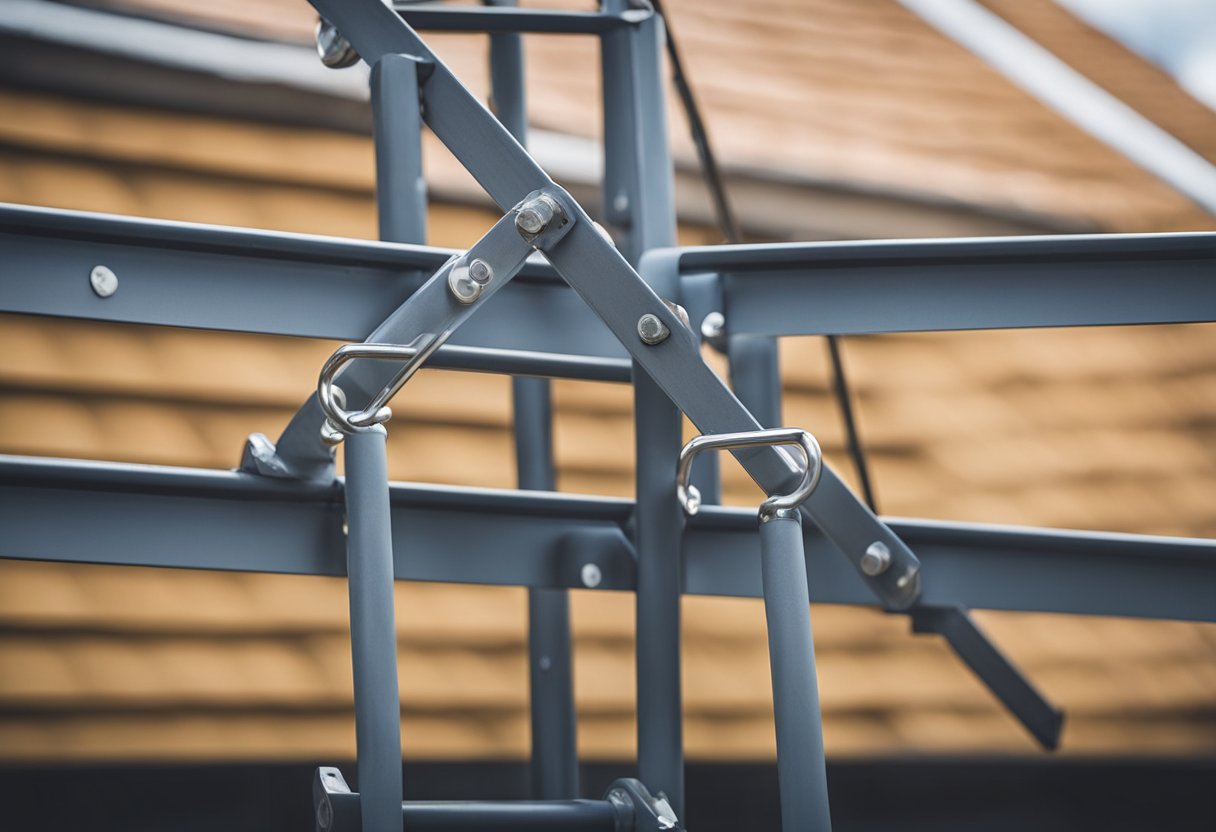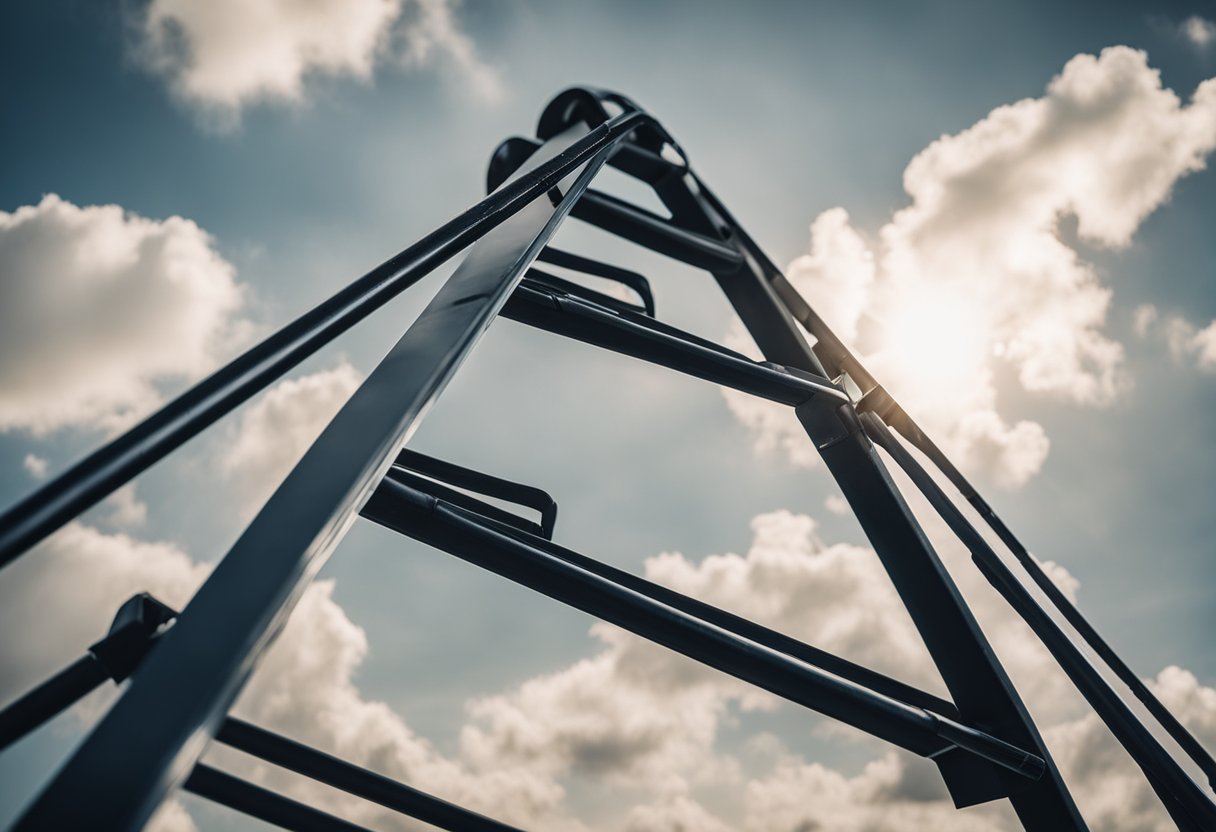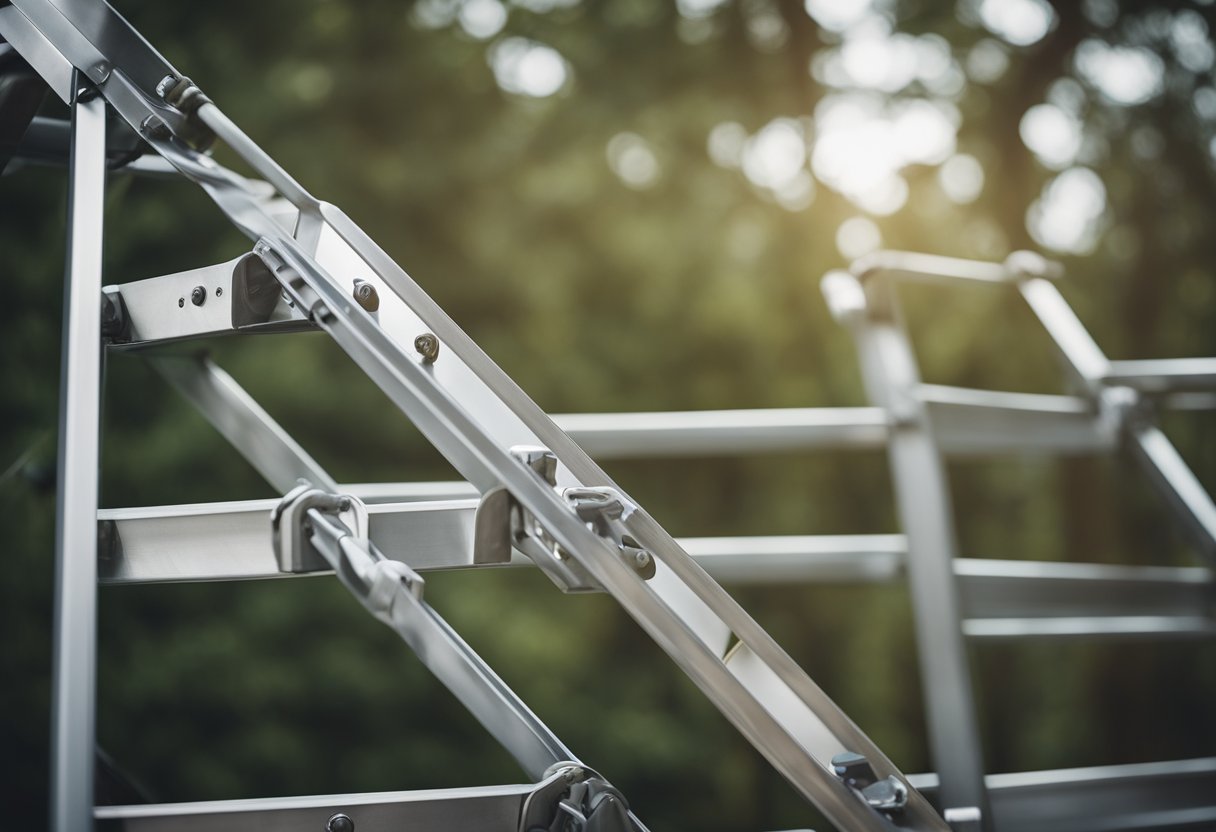As a homeowner, it’s important to know how to safely secure a ladder to a roof. Whether you’re cleaning gutters, repairing shingles, or hanging holiday lights, using a ladder is often necessary. However, improper ladder use can result in serious injuries or even death. By following a few basic steps, you can ensure your ladder is secure and prevent accidents.
Understanding the basics of ladder safety is key to securing a ladder to a roof. Before you even set up your ladder, make sure to inspect it for any damage or defects. You should also check the ground where you’ll be placing the ladder to ensure it’s level and stable. It’s also important to choose the right ladder for the job. For example, an extension ladder is ideal for reaching high places, while a step ladder is best for shorter tasks.
When securing the ladder to the roof, there are a few important steps to follow. First, make sure to stabilize the ladder by either using a ladder stabilizer or securing it to the ground with stakes. You should also use ladder hooks or brackets to secure the ladder to the roof. Finally, make sure the ladder is at the correct angle to prevent it from slipping or tipping over.
Key Takeaways
- Understanding ladder safety basics is crucial for securing a ladder to a roof.
- Stabilizing the ladder and securing it to the roof with hooks or brackets are key steps in ladder safety.
- Choosing the right ladder for the job can prevent accidents and ensure the ladder is secure.
Understanding the Basics
https://www.youtube.com/watch?v=IN_GPI1IMrs&embed=true
When it comes to securing a ladder to a roof, safety should always be the top priority. In this section, I will provide you with some basic information that will help you understand the key concepts of ladder safety.
Ladder Types
Ladders come in different shapes and sizes, and each type of ladder has its specific purpose. The most common types of ladders are extension ladders, which can be made of aluminum or fiberglass. Extension ladders are ideal for reaching high places, such as roofs, and they come in various sizes. It is essential to choose the right ladder for the job to ensure safety.
Roof Types
Roofs can be made of different materials, such as metal, shingles, or tiles. It is crucial to know the type of roof you are working on to determine the best way to secure the ladder. Some roofs are steeper than others, and this can affect the angle at which you place the ladder.
Ladder Placement
Before you place the ladder, you should inspect the ground to make sure it is level and firm. Soft, wet, or uneven ground can cause instability, which can lead to accidents. Once you have found a suitable location, you should place the ladder at a safe angle. For every four feet of height, move the base one foot away from the wall (4-to-1 rule).
Securing the Ladder
To secure the ladder to the roof, you can use ladder brackets or standoffs to create a stable base. You should also use straps or hooks to ensure that the ladder is level and not wobbly. It is crucial to follow the manufacturer’s instructions when securing the ladder to the roof.
Conclusion
In summary, securing a ladder to a roof requires careful consideration of ladder types, roof types, ladder placement, and ladder securing techniques. By following the basic guidelines outlined in this section, you can ensure your safety when working on a roof.
Ladder Safety Essentials
https://www.youtube.com/watch?v=A6v-9_QvCbc&embed=true
When it comes to working on a roof, safety should always be the top priority. Here are some ladder safety essentials to keep in mind:
Use the Right Ladder
First and foremost, make sure you are using the right ladder for the job. Check the weight limit and make sure it can support both your weight and any tools or equipment you will be carrying up with you. Also, ensure that the ladder is long enough to reach the roof without having to stand on the top rungs.
Wear the Right Safety Gear
Wearing the right safety gear can make all the difference in preventing injuries. Always wear a safety harness that is securely attached to the roof or another anchor point. Safety glasses can protect your eyes from debris or dust. A helmet can protect your head from falling objects. Gloves can provide a better grip on the ladder.
Maintain Three Points of Contact
Maintaining three points of contact with the ladder at all times is essential. This means that two hands and one foot or two feet and one hand should always be in contact with the ladder. This will help prevent slips and falls.
Use Safety Equipment
In addition to wearing the right safety gear, using safety equipment can also help prevent injuries. For example, ladder stabilizers can provide a secure base for the ladder, while ladder jacks can help level the ladder on uneven ground. Always follow the manufacturer’s instructions when using safety equipment.
Follow OSHA Guidelines
Finally, it’s important to follow OSHA guidelines when working on a roof. OSHA has specific regulations for ladder safety, such as the angle of the ladder, the distance between the ladder and the wall, and the use of safety devices. Be sure to familiarize yourself with these regulations before starting any work on a roof.
By following these ladder safety essentials, you can help ensure a safe and successful job on the roof.
Stabilizing the Ladder
https://www.youtube.com/watch?v=L9Q1DpaxkyA&embed=true
When it comes to securing a ladder to a roof, stabilizing the ladder is crucial to ensure your safety. A stable ladder prevents it from wobbling or tipping over, which can cause serious injuries. There are several ways to stabilize a ladder, and the method you choose depends on the type of roof and the ladder you are using.
One way to stabilize a ladder is by using ladder stabilizers. These are attachments that you can add to your ladder to increase its stability. Ladder stabilizers are designed to provide a wider base for the ladder, which helps to prevent it from tipping over. They can be attached to the top of the ladder, or to the bottom of the ladder feet. Ladder stabilizers are available in different sizes and shapes, so you can choose one that fits your ladder and your roof.
Another way to stabilize a ladder is by using ladder levelers. These are adjustable feet that can be attached to the bottom of the ladder. Ladder levelers are designed to compensate for uneven ground, which can cause the ladder to wobble. They are particularly useful when working on sloped roofs, where the ladder needs to be adjusted to maintain a level position.
Pivit brackets are another option for stabilizing a ladder. These brackets are designed to be attached to the roof, and they provide a stable base for the ladder. Pivit brackets are particularly useful when working on steep roofs, where it can be difficult to find a stable surface for the ladder.
In addition to using ladder stabilizers, ladder levelers, and pivit brackets, there are other ways to stabilize a ladder. For example, you can use sandbags or other heavy objects to anchor the ladder to the ground. You can also use ropes or bungee cords to tie the ladder to a solid object, such as a tree or a post.
Overall, there are many ways to stabilize a ladder when working on a roof. The key is to choose a method that is appropriate for your ladder and your roof, and to take the time to ensure that the ladder is stable before you climb up. By taking these precautions, you can help to prevent accidents and injuries when working on a roof.
Securing the Ladder to the Roof
https://www.youtube.com/watch?v=oRFaSbcc7hs&embed=true
When working on a roof, securing the ladder is crucial to ensure safety. There are several methods that can be used to secure a ladder to a roof, and the best option depends on the type of roof and the ladder being used.
One option is to use ladder hooks or roof hooks, which attach to the top of the ladder and hook onto the roof. These hooks are designed to grip onto the roof securely and prevent the ladder from slipping. It is important to ensure that the hooks are properly attached and that they are compatible with the type of roof being worked on.
Another option is to use straps to tie the ladder to an anchor point on the roof. This method is particularly useful for roofs without gutters or other structures to hook onto. Straps should be tight enough to prevent the ladder from moving, but not so tight that they damage the roof.
When securing a ladder to a roof, it is important to ensure that the ladder is stable and does not wobble or move. This can be achieved by placing the base of the ladder on a stable surface and using stabilization devices such as ladder stabilizers or roof anchors.
In summary, there are several methods that can be used for securing a ladder to a roof. Ladder hooks, roof hooks, straps, and stabilization devices can all be effective depending on the situation. It is important to choose the appropriate method for the type of roof being worked on and to ensure that the ladder is stable and secure before climbing.
Working on Different Types of Roofs
https://www.youtube.com/watch?v=XuknQZj2lsQ&embed=true
When working on a roof, it is important to consider the type of roof you are working on. Different types of roofs require different methods for securing a ladder. Here are some tips for working on different types of roofs:
Sloped Roofs
Sloped roofs can be tricky to work on, especially if they are steep. When securing a ladder to a sloped roof, it is important to find a stable location for the ladder. Look for a spot where the ladder can rest against the roof without slipping or sliding. If the ladder is not resting against the roof securely, it can be dangerous to climb.
Metal Roofs
Metal roofs can be slippery, so it is important to take extra precautions when working on them. When securing a ladder to a metal roof, use ladder brackets or standoffs to create a stable base. This will help prevent the ladder from slipping or sliding. It is also important to wear proper footwear with good traction when working on a metal roof.
Roof Safety
No matter what type of roof you are working on, safety should always be your top priority. Always use a ladder that is the appropriate height for the job and make sure it is in good condition. Inspect the ladder before each use to make sure it is not damaged or broken. When climbing the ladder, make sure to face the ladder and use three points of contact (two feet and one hand or two hands and one foot) at all times.
In summary, when working on different types of roofs, it is important to find a stable location for the ladder, use ladder brackets or standoffs when necessary, wear proper footwear, and prioritize safety at all times.
Preventing Ladder Accidents
As someone who has climbed ladders for years, I know that ladder accidents are a serious concern. According to the Occupational Safety and Health Administration (OSHA), falls from ladders are a leading cause of fatalities and injuries in the workplace. To prevent ladder accidents, it is essential to follow proper techniques and take precautions.
One of the most important things to consider when using a ladder is the correct angle. The ladder should be placed at a 75-degree angle, which means the base of the ladder should be one-quarter of the working length of the ladder away from the wall or surface it is leaning against. This angle ensures that the ladder is stable and will not wobble while you are climbing.
Another crucial factor to consider is the ladder’s length and duty rating. The ladder should be long enough to reach the working surface without standing on the top rung or step. Additionally, it should be rated to support your weight and any equipment you may be carrying.
To prevent ladder accidents, it is also important to take certain precautions. Always inspect the ladder for defects or damage before using it. Make sure the ladder rungs are clean and free of debris to prevent slipping. Use a personal fall arrest system if working at heights greater than six feet.
In conclusion, preventing ladder accidents requires proper techniques and precautions. By following the correct angle, using the right ladder length and duty rating, and taking precautions such as inspecting the ladder and using a personal fall arrest system, you can reduce the risk of injuries and fatalities.
Choosing the Right Equipment
When it comes to securing a ladder to a roof, choosing the right equipment is crucial for your safety. Here are some of the options you should consider:
Ladder Hook
A ladder hook is a convenient tool that attaches to the top of your ladder and hooks onto the roof. It works well on sloped roofs and can provide a stable base for your ladder. Make sure to choose a hook that is compatible with your ladder and roof type.
Stabilizer or Standoff
A stabilizer or standoff is an attachment that extends your ladder away from the roof. It provides extra stability and prevents the ladder from damaging gutters or other roof features. Make sure to choose a stabilizer or standoff that is compatible with your ladder and roof type.
Bungee Cord
A bungee cord is a simple and affordable way to secure your ladder to the roof. Simply wrap the cord around the ladder and roof and secure it in place. However, this method is not recommended for high winds or steep roofs.
Rails
Rails are another option for securing your ladder to the roof. They attach to the roof and provide a stable base for your ladder. However, they can be expensive and may not be compatible with all roof types.
Combination Ladders
Combination ladders are versatile tools that can be used as both a step ladder and an extension ladder. They are great for working on roofs because they can be adjusted to the perfect height and angle. However, they can be heavy and difficult to maneuver.
Tool Belt
A tool belt is a must-have accessory for anyone working on a roof. It allows you to keep your hands free and carry all of your tools with you. Make sure to choose a belt that is comfortable and has enough pockets for your tools.
Wind
Finally, it’s important to consider the wind when securing your ladder to the roof. High winds can knock over ladders and cause serious injury. Make sure to choose a secure location and use the appropriate equipment for the wind conditions.
By choosing the right equipment, you can ensure a safe and successful experience working on a roof.
Frequently Asked Questions
What are the best roof ladder hooks?
Roof ladder hooks are a great way to secure your ladder to the roof. They are designed to hook onto the edge of the roof and provide a stable base for your ladder. When choosing a roof ladder hook, look for one that is made of durable materials, such as steel or aluminum. It should also be adjustable to fit the pitch of your roof. Some popular brands of roof ladder hooks include Werner, Louisville, and Little Giant.
How do you secure a ladder to a permanent roof ladder?
If you have a permanent roof ladder, securing your ladder is easy. Simply place the ladder against the permanent ladder and secure it with a ladder stabilizer or tie it off with a rope or bungee cord. Make sure the ladder is secure before climbing up.
What is the PiViT ladder tool and how does it work?
The PiViT ladder tool is a device that helps you safely set up your ladder on uneven ground. It is made of durable plastic and has four adjustable legs that can be set at different heights. To use the PiViT ladder tool, place it on the ground and adjust the legs to level it. Then, place your ladder on top of the PiViT and adjust the legs as needed to make sure the ladder is stable.
What is a roof boot for a ladder and why is it important?
A roof boot is a rubber or plastic cover that fits over the end of your ladder and provides a non-slip surface. It is important because it helps prevent the ladder from slipping on the roof and damaging the shingles. Roof boots are easy to install and can be purchased at most hardware stores.
How do you secure a ladder on a steep roof?
Securing a ladder on a steep roof can be challenging. One way to do it is to use ladder stabilizers or ladder hooks. These devices attach to the ladder and provide a stable base on the roof. You can also use a rope or bungee cord to tie the ladder off to a secure anchor point on the roof.
How do you prevent a ladder from slipping on a roof?
To prevent a ladder from slipping on a roof, make sure the feet of the ladder are clean and free of debris. You can also use ladder stabilizers or ladder hooks to provide a stable base. If the roof is wet or slippery, use a roof boot or other non-slip device to prevent the ladder from slipping. Always make sure the ladder is secure before climbing up.

Hi, I’m Sal Muller of Tooltrip.com. My DIY experience led me to understand essential power tools for home projects. Tooltrip.com guides enthusiasts and professionals in choosing right tools for any job. I provide concise top tool reviews for easier, efficient DIY.





